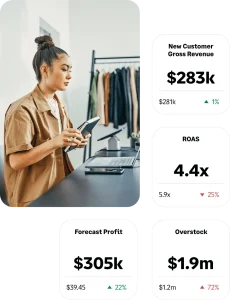By Piper Donnelly, Account Director, Awin
The costs of driving brand awareness and sales for retailers online are considerable and so is the competition. As companies fight for attention, they face social and economic uncertainties that threaten to disrupt consumer and brand spending. What’s more, with Google and Apple removing online identifiers that third parties use for targeting, brands must find new ways to form connections with desired audiences.
Regardless, consumers demand experience-defining support, and marketers must deliver real value to be relevant. With strategies from yesterday no longer cutting it, the following tips, and insight from industry leaders, can help retailers rise to the challenge and sharpen their online marketing and customer experiences.
#1 Double Down on Your Story
According to Jim Rudall, former head of revenue for Shopify, when times get tough brands should revisit how they first connected with customers. He noted: “The cost of acquisition and new customers is getting steadily more expensive, but you have this huge loyal customer base who fell in love with your brand to begin with, so how do you get them to engage with you in a more deep and meaningful way to reward their loyalty?” He suggests “doubling down on your story” with loyal customers to increase average order value and shopper frequency.
#2 Tune Your Channels
When consumers are anxious, place an emphasis on the marketing channels that perform best. For instance, social media is where consumers spend most of their time. TikTok more than doubled its user base between 2019 and 2021 and is expected to reach one billion users by 2025. This makes it an ideal for retailers to target popular influencers who in turn will rave about “their stores” to large communities of followers.
An emphasis for New York’s Tomahawk Shades has been the affiliate channel. The U.S. sunglasses market is the largest in the world, dominated by household names like Ray-Ban, Oakley and major retailers like Sunglass Hut. Tomahawk Shades wanted to establish its credentials through the voices and experiences of trusted authorities. So, in conjunction with a series of high-profile sport star endorsements, they hired digital marketing agency Today’s Business to take this approach to the next level.
The agency compiled a list of top-ranking articles, websites and additional datapoints to create a precise database of editors to target. They interviewed freelance fashion writers for insight into how to get noticed. Short video clips were then created highlighting unique selling points, directly messaged to editors to generate crucial coverage. In just one year, Tomahawk Shades realized a 77% increase in channel revenue, raising affiliate marketing’s share of ecommerce revenue by 12% and doubling its ROI.
#3 Getting Personal Versus Discounting
In stressful economic times, customers want brands to be empathetic to financial concerns. Discounting may boost conversion rates and increase sales, but it can reduce margins and tarnish a brand’s reputation. While consumers will seek deep discounts, retailers may do better to focus on offering more personal experiences.
Research from Deloitte has shown 69% of consumers are more likely to purchase from a brand that personalizes experiences. According to Amy Harman, head of customer marketing for Hotel Chocolat: “[Customers] want a personalized, immersive experience. If you just give them discounts, they’ll just become deaf to it.” That said, focus on the end-to-end customer journey to understand what lifts satisfaction, loyalty and advocacy.
Intent.ly, the leader in optimizing customer conversions, found an answer by making it easy for partners to leverage its technology. This lowers basket abandonment rates, improves conversions and grows margins via intelligent, personalized prompts. The state-of-the-art technology can also be deployed on partner sites in minutes.
#4 Driving Decisions with Data
Leading retailers use data to drive decision making. For gen.video, data identified influencers and content creators in the best position to promote specific HP products. This was made possible by data culled from previous social content on gen.video’s influencer platform, mixed with conversion analytics via affiliate tracking technology.
When it came to HP’s OMEN laptops, analysis of KPIs such as average order value and click-to-sale times unearthed distinct audience profiles. Influencers whose followers took more time considering purchases, but spent big when they did, were tapped to create content for the premium product line. This produced a 70% increase in clicks and the doubling of organic viewership over target goals.
#5 Outsource to Overcome Shortages
As a way to lower costs and overcome cuts to resources, enlist partners, particularly those with AI and automation expertise. This can enable retailers to streamline processes, mine data for enhanced decision making and accomplish more with less.
Brendan Witcher, principal analyst at Forrester, believes: “Automation will be the savior for continued retail labor shortages. Ripple effects from the ‘Great Resignation’ will force retailers and brands to invest more heavily – and more strategically – in automation. Investments will automate functions required to run the business in corporate areas – for example marketing, HR, analytics – and in the store.”
What’s more, a 2022 Gartner survey of chief marketing officers (CMOs) identified data and analytics as a top capability gap, followed by customer understanding, experience management and marketing technology. More than 60% of CMOs noted their teams lack such key capabilities, punctuating the need for retailers to establish strategic partnerships with those that do.
#6 Stick To The Plan
Finally, while the knee-jerk reaction might be to cut marketing spend in tough times, it could be a big mistake: Retailers and brands will likely fare better if they stick with the strategic plans they painstakingly developed.
The Gartner CMO survey appears to back this up. Though budgets for CMOs as a percentage of company revenue hit a record low of 6.4% in 2021, they rose sharply to 9.5% in 2022. What’s more, retail climbed from 6.3% to 9.1%, while budgets for CMOs in consumer goods firms remained unchanged.
The takeaway is marketers should continue investing during tight fiscal times to ensure customer connection and relevancy. Further, when economic conditions do change for the better, an organization can experience particularly rapid growth and leapfrog ahead of competitors. On the other hand, halting efforts can break bonds, enabling competitors that persisted to steal a retailers hard-earned momentum and customers.
In short, the smart marketing money is on maintaining customer connection and relevancy in 2024.
About author
 Piper has worked at Awin for over five years, managing influencer and affiliate programs by leveraging digital strategies to empower brands. Prior to joining Awin, Piper was a digital strategist for Bell Media and a copywriter for Verge Pipe Media.
Piper has worked at Awin for over five years, managing influencer and affiliate programs by leveraging digital strategies to empower brands. Prior to joining Awin, Piper was a digital strategist for Bell Media and a copywriter for Verge Pipe Media.
Related Articles

LegitScript’s Data Reveals 1200% Increase in Violative and Problematic Advertisements for GLP-1 Medications
LegitScript Has Seen Nearly a 100% increase in New Applications for its Healthcare Merchant Certification Program Year Over Year

Merchants Are Spending 332 Hours Each Year On ‘Overwhelming” Admin
Polling over 1,000 businesses, the study found that US merchants dedicate 6 hours and 24 minutes weekly on manual admin tasks, 27 hours and 44 minutes per month, and 332 hours per year.

Live Shopping: The Silver Bullet to Product Returns?
“Direct interaction leads to more informed purchases, as customers feel more confident asking questions and seeking clarification on products before buying, ultimately reducing the likelihood of returns,” writes Kenneth Tan, Co-Founder and CEO of BeLive Technology

A New Era of Retail Customer Obsession
Brands like Polestar, Vinted and Home Depot are changing how they manage their customer journey. What can leaders learn from this?



 for the latest news and job opportunities in retail tech
for the latest news and job opportunities in retail tech 